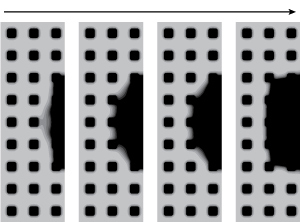Self-cleaning surfaces: The importance of a single groove

Computer simulations show that when liquid infiltrates a single gap between microscopic pillars (left), it causes extensive wetting on superhydrophobic surfaces. Reproduced, with permission, from Ref. 1 © 2014 American Chemical Society
‘Superhydrophobic’ surfaces, such as anti-icing or self-cleaning windows, are remarkably effective at repelling water molecules. However, they may suddenly — and dramatically — lose their superhydrophobic features. A*STAR researchers have now identified a cause for the widespread ‘wetting transition’ by pinpointing how infiltration of a single microscopic groove can cause such an event[1].
Weiqing Ren from the A*STAR Institute of High Performance Computing and the National University of Singapore used a ‘climbing string’ computational technique to model a micropatterned surface that uses microfabricated pillars to trap air pockets and so repel water molecules.
When a water droplet contacts a superhydrophobic interface, it immediately beads up and forms a near-perfect sphere. Under conditions of thermal or vibrational stress, however, the water droplet collapses and fully wets the substrate. This transition occurs when enough work is supplied to cross a bottleneck, known as an energy barrier, connecting the wet and dry states.
Identifying where energy barriers occur on micropatterned surfaces could dramatically improve their manufacture. A promising way to study this problem is by using computer models of ‘minimum energy paths’ (MEPs), which are intermediate structures during the transition between two states. Currently, most algorithms are designed to only identify the points in a system where energy minimums occur; the unstable nature of energy barriers makes them trickier to spot.
Ren’s method strings together the wet and dry minimum energy states through a smooth curve. An algorithm then seeks out MEPs available for the transition by shifting the string’s endpoint to higher and higher energies. This changes the string shape and eventually a ‘saddle point’ emerges when the physical forces acting on the curve reach a steady state. The shape of the saddle point corresponds to the energy barrier.
“Unlike other techniques, the climbing string method gives direct control over the energy of the evolving endpoint — guaranteeing that the computed saddle point is directly connected to the particular energy minimum,” says Ren.
Simulating a superhydrophobic grid of microscopic pillars with the climbing string algorithm revealed the mechanisms of wetting in striking detail (see image). The critical saddle point proved to be the entry of a small quantity of liquid into a single groove between micropillars. Crossing this barrier enabled the liquid to propagate laterally across the surface in a stepwise fashion, often nucleating from a central point before zipping along the grooves and filling them.
“By numerically studying energy landscapes, we now have a quantitative basis for designing optimized patterned surfaces in engineered systems,” says Ren.
Reference
1. Ren, W. Wetting transition on patterned surfaces: Transition states and energy barriers. Langmuir 30, 2879–2885 (2014).
Associated links
Media Contact
More Information:
http://www.researchsea.comAll latest news from the category: Materials Sciences
Materials management deals with the research, development, manufacturing and processing of raw and industrial materials. Key aspects here are biological and medical issues, which play an increasingly important role in this field.
innovations-report offers in-depth articles related to the development and application of materials and the structure and properties of new materials.
Newest articles

High-energy-density aqueous battery based on halogen multi-electron transfer
Traditional non-aqueous lithium-ion batteries have a high energy density, but their safety is compromised due to the flammable organic electrolytes they utilize. Aqueous batteries use water as the solvent for…

First-ever combined heart pump and pig kidney transplant
…gives new hope to patient with terminal illness. Surgeons at NYU Langone Health performed the first-ever combined mechanical heart pump and gene-edited pig kidney transplant surgery in a 54-year-old woman…

Biophysics: Testing how well biomarkers work
LMU researchers have developed a method to determine how reliably target proteins can be labeled using super-resolution fluorescence microscopy. Modern microscopy techniques make it possible to examine the inner workings…





















